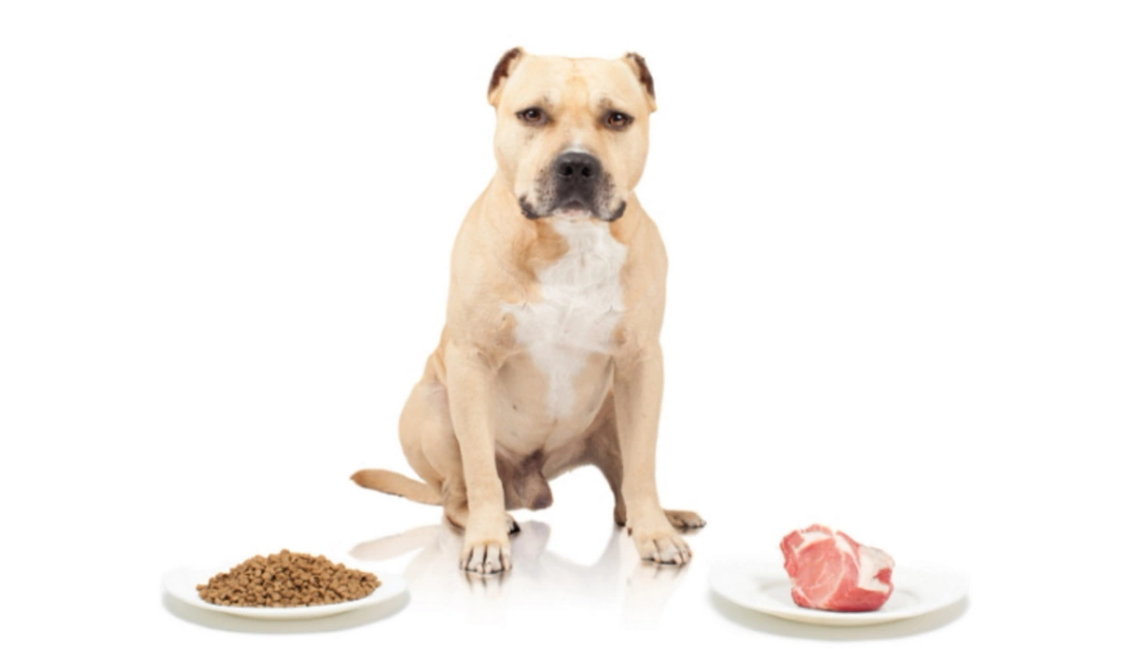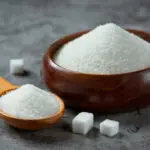(Original Article Published via RawFoodForPets.com)
So Many Choices, so Little Information …
Fur kids have been fed McKibble and McCan for the past eighty or so years with what seems to be great results. Dogs are not dying outright from starvation or malnutrition, and seem to be happy and fairly healthy. You certainly can get dogs with glossy coats and healthy bodies (healthy being used loosely) that live well into their teens while being fed McKibble and McCan. Yet the veterinary community has been seeing increases in things like cancer, obesity, diabetes, unilateral hip dysplasia, dermatitises, food allergies, kidney problems, pancreas problems, and liver problems (and their medical techniques and methods have evolved tremendously to deal with these; many veterinarians are very capable people who mean well and can be quite good at treating illness and disease).
Just about every system in the dog has been affected in some way, shape, or form by some disease or problem that did not “exist” prior to the advent of McKibble or McCan, or was not recognized as a big issue in a similar manner as us pet parents are starting to awaking to nutrition ourselves. Part of this increase is due to the fact that more people own pets today and that illnesses are more quickly diagnosed nowadays, but many of these diseases have been shown to have strong links to diet – particularly in huuman research (like adult onset diabetes and obesity and cancer, for example). Many of our pets’ body processes parallel our own, so who is to say that processed food will not affect them similarly?
But on the whole, most pet owners are happy to feed their dogs McKibble and McCan, and coexist with smelly dog turds and stinky dog breath. Dogs are dogs; they are supposed to smell, right? Within the past 10-15 years or so it has finally been recognized that stinky breath is a problem for dogs because it underlies a bigger problem: periodontal disease. The pet industry has played off of this tremendously, bringing about an era of pet chews, dental bones, toothbrushes, toothpastes, plaque-scraping feeds and chewies and toys, etc. More things to spend your money on because your fur kids needs them to be healthy, right? The problem of big smelly dog turds has everyone up in arms, as these turds pollute our parks, side-walks, streets, and communities. It is the responsible owners or pet parents who have to suffer, as the turd problem has resulted in stricter leash laws, dog ownership laws, and in some communities an outright “dogs are not welcome” attitude, plus a plethora of “quick fixes” to help manage the problem: pooper scoopers, waste digesters, special scooping baggies to carry with you on walks, extra enzymes to add to the dog’s food so it will digest more of it. Has anyone ever questioned why they do not treat these problems at their source instead of just dealing with the symptoms as they surface?
Yes, people have questioned this as well as the whole idea of pet food; hence, raw fooding, or natural diets, has been “resurfacing“, so to speak. People call it a “fad” without realizing that raw fooding has been around a heck of a lot longer than kibbled foods: one million years of raw to only 100 years – at the most – of kibble. Pelleted, processed food is the fad that has somehow managed to integrate itself into every single aspect of our pets’ lives: medical care, training, leisure, nutrition, showing, breeding, you name it. This is, by and large, the way people feed their pets. It is easy, convenient, relatively cheap, and provides a much-needed outlet for all the waste products we as a society create. Some entrepreneurial person – James Spratt – got the idea of feeding “biscuits” to our dogs as a meal, and the very first dog kibble was born. These biscuits then evolved into foods that contained all the meats and by-products that were no longer fit for huuman consumption (particularly after the 1906 Pure Food and Drug Act and the 1906 Meat Inspection Act was passed in the United States, which created the “meat dichotomy” of “fit for human consumption” and “unfit for human consumption”. Something had to be done with all that “unfit” meat…), and thus modern commercial foods were created. Kibbled pet feed is simply a by-product of our industrial era that ushered in modernity and the desire to do things cheap, easy, and fast. It is no wonder that many of the big-name brands of dog food are made by companies that create a lot of other food products. They have easy access to cheap ingredients made by their own factories.
But McKibble and McCan have come a long way since their early prototypes. They have improved much, and there are a number of smaller companies that produce holistic, organic, or premium kibbles from huuman grade ingredients that are of great quality as far as commercial feeds go. The majority of pet owners are happy to just feed brand-name, pre-made foods to their pets because it is convenient, easy, and their animals eat the food and appear to do well on it. They are part of the consumer society that swallows slick advertisements hook, line, and sinker. And if there is one thing pet food companies have down, it is advertising. They advertise all over the place: on TV, on the web, in hundreds of magazines, in schools, at dog shows (think of the Eukanuba Tournament of Champions; free bags of the sponsor’s kibble are given to the winners at many dog shows.), at zoos, on billboards, and (most importantly) in your veterinarian’s office (think of all those shelves filled with Purina foods, Hill’s Science Diet, etc.). Raw fooding, however, has no such advertising capabilities, because people are supporting their local butchers, ranchers, farmers, resellers such as ourselves, etc., and are encouraging sustainable living practices rather than paying big bucks to make people buy some commercially-produced product. Raw fooding’s advertising is through word-of-mouth and through the healthy dogs and cats that are fed such a diet.
One can rightfully ask: why raw and not kibble? People are asking that every day, and some are coming to the realization that while their fur kids may be doing well, they could be doing better. This is one of the reasons pet parents, guardians and slaves switch their pets if their pets do not have some major health problem. They switch because they believe their dogs or cats can have better quality lives if they are fed a raw real food diet. Sure, the dog’s coat may be shiny and it may have a fit body while eating kibble, but they believe raw fooding can make it better and healthier.
A kibble-fed dog, while exhibiting a soft, shiny coat and a seemingly healthy body will often still exhibit the following:
- Dog breath (rancidity and stinkiness may vary);
- Stained teeth, tartar covered teeth, or teeth encrusted with calculus;
- Periodontal disease (85% of kibble-fed dogs over the age of 3 have this);
- Itchy skin Doggy odour to coat (varies in intensity);
- Body is too flaccid and may feel soft or ‘doughy‘ to the touch, despite dog maintaining the proper weight;
- Large poops relative to body size that do not decompose quickly (softness and stinkiness may vary);
- Small fatty benign tumours that thrive from the constant supply of sugars provided by all the carbohydrates in the diet;
- Greasy feel to the coat (greasiness may vary), resulting in frequent (once a month or more) bathing;
- Premature ageing caused by periodontal disease and immune system “overload” (immune system is constantly working against the toxins pouring into the body from the mouth and is in a constant state of arousal [Dr Tom’s book]).
Most people consider all the above-mentioned problems normal (how did we get to the point where we consider all this normal?). Since most people have never encountered raw fed dogs, they do not know what they are looking for and do not have anything to which they can compare their dogs. They may think their dog’s breath and health is fine until they smell a raw-fed dog’s breath and “see” its health, just like many people think their dog is “well-trained” (it “sits” and “comes” when they ask…sometimes) until they come across a truly impeccably trained animal.
Raw fooding pet parents, guardians and slaves have woken up to the fact that their pets could have a better quality of life if they were fed a species appropriate raw and real food diet that nature designed for them. They realized that there is a big difference between eating enough to survive and eating well, fooding to thrive. Kibble provided their pets with sufficient caloric intake and seemed to meet all their pets’ nutritional requirements, but were their animals really living well and healthfully? They said ‘no’, and turned to a more natural way of feeding their animals.
Is Raw Dog Food Better than Kibble?
At DoggyChef, we believe so, however, it is also a loaded question. Is McDonalds better than a freshly home cooked meal? Or perhaps Burger King? Do you want your cats and dogs to thrive, or survive? What did our great grandparents feed their dogs and cats? It was not McKibble, it was real food.
Bar all of the so-called research for both camps, let us consider the statements in the tables below for comparisons.
Consider this – an average dog of around 25 kilograms, eating McKibble for a year, will consume approx 8 kilograms of preservatives and other inappropriate chemicals, whereas on real food, none.
In the end, you would need to evaluate:
- does real food fit your lifestyle?
- do you think it is affordable?
- is your pet worth the investment?
–
Again, ignoring the arguments for and against, the so-called research or lack therefore, or the so-called bacterial risks, consider the answer to the following question: if you where to be placed in the care of another, would you expect them to provide you with real or synthetic nourishment?
Many argue that you cannot produce a raw meal based on the NRC nutritional requirements for canine and feline, however, we argue that you can, and our catalog and Directory of supreme cuisine demonstrate this fact.
You also have to ask yourself this: if in 3 million years of human evolution we keep on screwing up our own dietary requirements and nutritional needs, and the understanding thereof, how then can we claim to know what an animal such as a dog or a cat really need, when they cannot provide feedback, and claim to have mastered these needs and gain knowledge in a mere 80 years?
We therefore DO think that raw and real food is better than McKibble and McCan, but then we are biased as we believe the investment in our pets is worth every penny.
What are The Benefits of a Raw Biologically Species Appropriate Diet?
One of the first things you will notice about dogs and cats being fed the biologically species appropriate diets is better quality of life! Living enzymes are proteins found in raw foods which help the body function. Enzymes are only beneficial to the body if they are living. Once food is cooked or processed, it no longer contains living enzymes. Foods without living enzymes can put stress on your pets’ pancreas to produce the necessary proteins to function. Living enzymes in a raw diet will assist in the restoring, repairing, and maintain health. Animals typically replenish their enzymes systems by eating raw unprocessed foods. Convenient packaging retains the living enzymes, along with phytochemicals, antioxidants, and unprocessed amino acids.
Your pet’s long term health depends upon these factors to ensure a long and healthy lifespan.
- Healthy Teeth & Breath – Your pet will have much-improved breath, minimal tartar build-up, and beautifully clean and healthy teeth; all without having to visit the pet dentist or brushing the teeth. In addition, we have observed that periodontal disease that is so prevalent with pets fed grain-based diets is almost non-existent in those fed on biologically appropriate raw diets.
- Healthy Skin & Coat – Typically, this will be one of the first changes you will notice when you start feeding on a biologically appropriate raw diet. If those persistent skin problems suddenly disappear or improve, and you no longer need vet visits, medicated washes, antibiotics, cortisone shots and cortisone tablets, it allows us to draw to conclusion that the natural, healthy, and raw diet is supplying nutrients that other diets are missing.
- Optimum Immune System – Biologically appropriate raw diets will assist your fur-kid to normalise and strengthens the immune system. The immune system is a wonder of creation. Because our biologically species appropriate raw diets contain a good balance of essential fatty acids and other immune normalizing and strengthening nutrients, it will assist in reducing inflammatory conditions and waves good-bye to infections.
- Degenerative Disease – Pet parents that switch their older pets to biologically appropriate raw diets usually find that whatever degenerative disease their pet has contracted becomes less of a problem. Biologically appropriate raw diets are not a wonder drug, but it has assisted in containing aggravating degenerative conditions and has given relief to a variety of diseases. One should only read the various testimonials to see the dramatic changes that a biologically appropriate diet can make. Even arthritic conditions can be improved and you can expect to see greater mobility in your fur kids.
- Stool Volume & Odour – Reduced stool volume and odour is a typical sign of an improved and healthy digestion cycle. Biologically appropriate raw diets are more readily absorbed than grain fed diets in the digestive system, and the result is less stool volume and odour. Odorous stools typically are a result of improper or incomplete digestion of nutrients.
- Healthy, Lean Body Mass – By feeding biologically appropriate raw diets and regularly exercising your fur kids, your pet will lose unwanted fat and gain that much desired increase in muscle mass. The effect will be more rapid if you combine the biologically appropriate raw diet with some normal exercise. This not only makes your fur kids look better, it increases your pet’s metabolic rate, its activity levels, and its healthy life span.
–
And my cat(s)? Some Changes to Expect – and the rewards for all your patience!
- After a full transition to a raw diet, cats typically will drink less water. Cats in the wild get most of their water from their food. A raw meat diet naturally contains more moisture than dry or canned food, so your cat may be less thirsty, yet be getting plenty of water.
- There may be a change in the volume, odour, and colour of faeces. It will stink less! It may also be somewhat harder and dryer and be coloured shades of dark and light brown. Much of the crude protein and crude fibre in most commercial dry and canned cat foods is not digestible and contributes to a higher volume of stool. Along with the assurance of knowing that all the food that is ingested is being digested, the reduction of odour is a nice side-benefit.
- Overweight cats tend to lose weight. However, weight loss must be closely monitored. Rapid weight loss can lead to serious health problems. A holistic veterinarian who is skilled in transitioning to raw diets can provide the best advice, especially when transitioning a cat with chronic health issues.
- Lethargic cats start to play more and may even exhibit hunting behaviour. Cats are healthiest when fed a high protein, low carbohydrate diet. When cats aren’t experiencing the metabolic highs and lows associated with high carbohydrate intake from grains, they will use protein as their energy source, as they were designed by nature to do. This tends to provide more sustained energy throughout the day and reduces the need to “graze”.
- Allergies tend to clear up, which may be a result of less exposure to potential food allergens. Many cats have allergies to grains that can range from very mild to severe. These allergies can manifest on the skin, can affect digestion, and also contribute to runny nose and eyes. The reduction in allergic symptoms may be a result of not only a reduced exposure to allergens from a higher quality food, but also from a stronger immune system. The more nutritious the food, the stronger the immune system will be.
- Fur becomes incredibly soft and shedding is reduced. This can be the result of better nutrition and is typically one of the initial benefits observed after changing cats to a raw diet. There may also be a reduction in human allergic reactions to cats due to the reduction of dander.
Pro’s and Con’s Kibble
| Pro | Con |
| Cost Effective | Lot’s of fillers, lot’s of waste |
| Convenient | Grains, cereals and non specie appropriate bits |
| Easy to serve | Highly processed |
| Simple to store | Synthetic food fragments |
| Long shelf life | Synthetic vitamins |
| Easy to transport | No life essense |
| Range of choice | Preservatives |
| Perceived less risky | Use of colourants and other chemical additives |
Pro’s and Con’s Raw Food Diet
| Pro | Con |
| Healthier real food | Can be messy |
| Improved stools, less waste | Require freezers |
| Natural nutrients | Require freezer space |
| Full of life essence | Perceived risky |
| Improved self | Perceived expensive |
| No preservatives | Require frozen transport |
| No colourants or additives required | Limited choice |
| No heat processing involved | DIY time consuming |
Our advice: food a fresh raw food diet to your fur kids. It’s the most important component to promote a long and healthy life for your animals. You might see such radical changes that you’ll be inspired to overhaul your own diet! We ended up doing just that!
However, we also realise that many of our pet parents and guardians need convenience in your busy lives. We want fast food and our food fast – for our animals and for ourselves. The easy answer is dry food, the answer most of us accepted with little thought about the effect of dry food on general health of our fur kids. Food has not been considered very important for human health for a long time, let alone for our pets. However, we are beginning to understand that there is no substitute for eating real food ourselves. The same is true for our fur kids. Many of the chronic and acute diseases suffered by huumans and animals are directly related to diet.
If your fur kids are already bursting with health, you may not see a big difference when you switch to fresh food. If your fur kid has chronic health problems, you are likely to see those improvements. You may notice that some of the small problems you thought were “just age” have diminished, even disappeared.
We think you’ll see and feel a big change.





